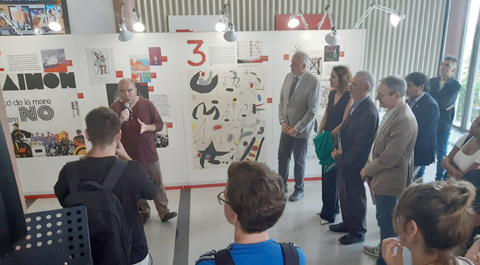Exhibition on the printed image of anti-Franco visual cultures inaugurated
Starting today 6 October, the exhibition "La imatge impresa en les cultures visuals de l’antifranquisme. Els anys de l’Assemblea de Catalunya" will be on display at the Journals Hall of the UAB Faculty of Arts & Humanities. The exhibition was inaugurated by UAB Rector Javier Lafuente and Minister for Justice, Rights and Historical Memory Gemma Ubasart, who highlighted the great educational and documentary value of the exhibit samples.

Catalan Minister for Justice, Rights and Memory Gemma Ubasart, and UAB Rector Javier Lafuente, alongside Memorial Democràtic Director Jordi Font, Faculty of Arts & Humanities Secretary and Vice Dean Jordi Cerdà, and art commissioner and UAB Doctor in History of Art Narcís Selles, inaugurated on 6 October the exhibition on visual cultures from the anti-Franco movement: La imatge impresa en les cultures visuals de l’antifranquisme. Els anys de l’Assemblea de Catalunya. The exhibition will be on display at the Journals Hall of the Library of Humanities for the following months. Also attending the inauguration were UAB General Secretary Esther Zapater, and Catalan Member of Parliament and of the Commission for Justice Jaume Butinyà.
The exhibition aims to show the enormous importance of the arts and visual cultures in general in a decisive moment in which Spain was transitioning to democracy, in which there was a fight against the Francoist dictatorship and a move towards democracy. It is made up of a set of artistic pieces, engravings, books, magazines, and other items published in Catalonia, Valencia and the Balearic Islands during the period of repression under the dictator Franco.
The exhibition forms part of the commemorative events celebrating 50 years since the constitution of the Assemblea de Catalunya and aims to be a recognition of the diversity of people, groups, entities and organisations coming together to fight for individual and collective rights. It highlights the use of graphic artwork as a tool in fighting against the Francoist regime and as a mechanism for the dissemination of democratic values and freedom.
Coinciding in time with the founding of the UAB
In his speech, Rector Lafuente pointed out that "as rector of the UAB I cannot highlight enough how that moment coincided with the first years of our University: a convulsive and hopeful period which strongly marked the character of the UAB". He went on to say that "the beginnings of the UAB represented a breath of fresh air within a context of darkness and lack of freedom".
In the years 1972 and 1973, the UAB began a protest and resistance movement against the authoritarian Spanish regime which later would be reflected in the Bellaterra Manifest of 1975, the first articulate document demanding a democratic and autonomous university based on Catalan values. According to Rector Lafuente, this period was known for its university assemblies, and also for its clandestine posters, political leaflets and publications that brought together and motivated society. "It was therefore a wise decision to have this exhibition on display here at the University, because new generations must be made fully aware of a fundamental period in our recent history", he concluded.
Minister Gemma Ubasart, a UAB alumnus, spoke also in this line and emphasised the importance of "the new generations understanding that the freedoms we have today are the results of the struggles seen in the exhibition". She also highlighted the fact that it was exactly the UAB that should host this exhibition because of "the critical and open spirit characterising the UAB that has made her a spearhead in Catalonia's student movement". That is why, she pointed out, the exhibition has such an "educational and documentary value".
Art commissioner Narcís Selles spoke on some of the exhibition's pieces and reminded attendants that "the contents of this exhibition are not only important because of their symbolic component in favour of a political change, but also for their aesthetic and artistic value".